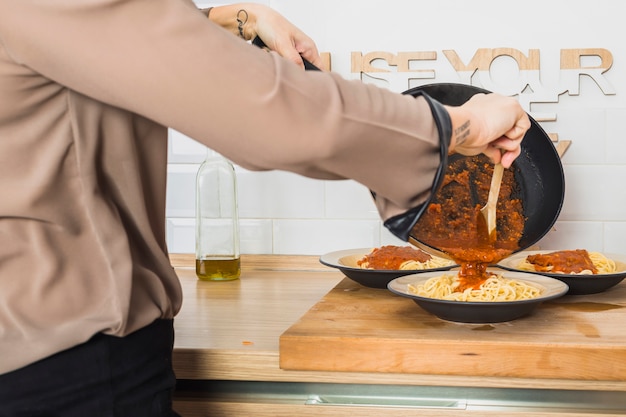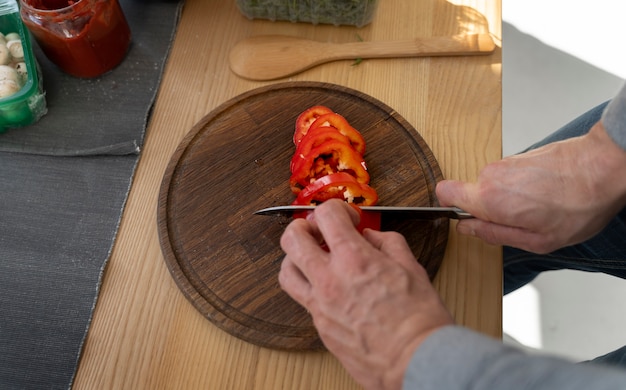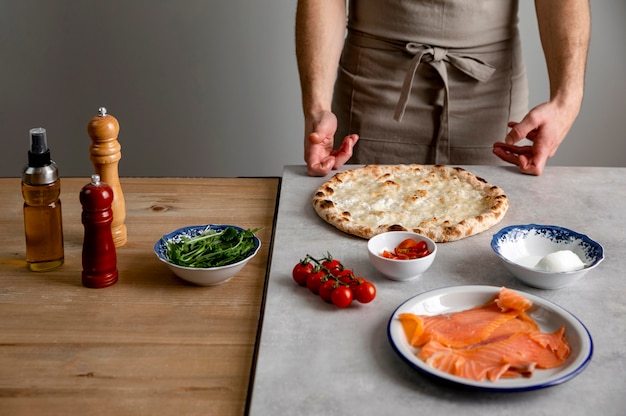I've got a confession: I'm a crab leg enthusiast. There's something undeniably satisfying about cracking open that shell, revealing the succulent, juicy meat, and dipping it into a pool of melted butter. It's a culinary experience that always makes me feel like I'm on a seaside vacation, even if I'm just in my own kitchen. But let's be real, cooking crab legs can be a little daunting. You want to get that perfect balance – cooked through but still tender and juicy. Overcook them and the meat becomes tough and dry; undercook them, and you're left with a fishy, raw flavor. Over the years, I've learned a few tricks and tips to ensure those crab legs are cooked to perfection, and I'm sharing them all with you!
(Part 1) The Basics of Cooking crab legs

The first step in mastering crab legs is understanding the two main cooking methods: steaming and boiling.
1. Steaming: The Delicate Approach
Steaming is my go-to method for a reason. It's gentle, it allows the crab legs to retain their natural juices, and it delivers a flavor that's simply unmatched. It's like giving the crab legs a spa treatment!
- Get Your Equipment Ready: Grab a large pot with a steamer basket that fits snugly inside. Think of it as a mini-sauna for your crab legs!
- Add Water, but Not Too Much: Fill the pot with just enough water to cover the bottom – about an inch or two. Remember, we're steaming, not drowning our crustacean friends.
- Time to Get Aromatic: This is where the fun begins! I love adding a few slices of lemon, fresh thyme sprigs, and a bay leaf to the water. It adds a beautiful fragrance and depth of flavor. Feel free to experiment with other herbs like rosemary, parsley, or even a splash of white wine for a more sophisticated touch.
- Bring It to a Boil: Once the water is bubbling away, gently place the crab legs in the steamer basket, making sure they're evenly spaced. Imagine you're arranging them for a crab leg fashion show – they deserve to be showcased!
- Cover and Steam: Pop the lid on and let the steam work its magic for 10-15 minutes. The cooking time will depend on the size of your crab legs, so keep a close eye on them. Smaller legs will cook faster, while larger ones will need a bit more time to reach their full potential.
- Check for Perfection: After 10 minutes, check one of the larger legs by gently pulling apart one of the joints. You're looking for meat that's white and opaque. If it's still translucent, give it another 2-3 minutes in the steamer.
- Serve and Enjoy: Once those crab legs are cooked, carefully remove them from the steamer basket. It's time to dig in! Serve them hot with melted butter, lemon wedges, and your favorite dipping sauce. The possibilities are endless!
2. Boiling: A Quick and Easy Method
Boiling is a classic technique that's quick and straightforward, making it a great option when you're pressed for time. However, it can sometimes result in slightly tougher meat compared to steaming. If you're short on time, boiling is a good choice, but don't expect the same level of tenderness as steaming.
- Grab a Large Pot: You'll need a pot that's large enough to comfortably accommodate your crab legs. Imagine a luxurious crab leg jacuzzi!
- Add Water: Fill the pot with enough water to cover the crab legs by a couple of inches. We want them to be fully submerged and ready for their aquatic adventure.
- Aromatic Enhancements: Just like with steaming, add aromatics to the boiling water for extra flavor. I like to add a few slices of lemon, a bay leaf, and some black peppercorns for a spicy kick.
- Bring It to a Boil: Once the water is furiously boiling, carefully add the crab legs to the pot. Make sure they're completely submerged in the water.
- Boiling Time: Let the crab legs simmer in the boiling water for 10-12 minutes. The exact cooking time will depend on the size of the legs, so keep a watchful eye.
- Check for Doneness: After 10 minutes, check one of the larger legs by gently pulling apart one of the joints. You're looking for white, opaque meat. If it's still translucent, give it another 1-2 minutes in the boiling water.
- Time to Scoop: Once the crab legs are cooked, carefully remove them from the pot using tongs or a slotted spoon. Avoid splashing, it's a hot date!
- Serve with Style: Serve the crab legs piping hot with melted butter, lemon wedges, and your favorite dipping sauce. It's time to enjoy the fruits of your labor!
(Part 2) Tips for Perfect Crab Legs

Now that you've got the basics down, let's delve into some tips that will elevate your crab leg game.
1. choosing the right crab Legs: A Connoisseur's Guide
The journey to perfect crab legs begins with selecting the right ingredients. You want fresh, firm crab legs with a slightly sweet aroma. Avoid any legs that have a fishy odor or are slimy – that's a sign they're not fresh.
At the grocery store, look for crab legs that are packed in ice and have a bright, vibrant color. If possible, choose crab legs that are still attached to the body, as these are usually fresher and have a better flavor. The body provides a little extra meat, and it's a good indicator of freshness.
2. Thawing frozen crab legs: A Gentle Approach
If you're using frozen crab legs, thawing them correctly is crucial. The best method is to thaw them slowly in the refrigerator. Place them on a plate or in a container and let them thaw overnight. The slow thaw will ensure that the meat doesn't become mushy or lose its flavor.
You can also thaw crab legs in cold water, but make sure to change the water every 30 minutes to ensure they thaw evenly. Avoid thawing them at room temperature, as this can lead to bacterial growth.
3. Don't Overcook: The Art of Timing
The biggest mistake people make when cooking crab legs is overcooking them. Overcooked crab legs become tough, dry, and the meat has a rubbery texture. Not a pleasant experience!
It's always better to err on the side of undercooking than overcooking. You can always cook them for a few more minutes if they're not quite done, but once they're overcooked, there's no turning back. Think of it like a delicate dance with heat – you want to get it just right!
4. The Importance of Dipping Sauce: A Flavor Explosion
Let's face it, a delicious dipping sauce elevates a crab leg meal to a whole new level. My go-to sauce is a simple mix of melted butter, lemon juice, and a pinch of garlic powder. It's classic for a reason! But feel free to get creative with your dipping sauce. Try a spicy dipping sauce, a creamy garlic sauce, or even a mango salsa for a tropical twist. The possibilities are truly endless!
(Part 3) Cooking Crab Legs for Different Occasions

The art of cooking crab legs isn't just about the perfect technique; it's about choosing the right crab legs for the occasion. Whether you're having a casual family dinner or a fancy gathering, there's a perfect crab leg option for every event.
1. Casual Dinner: A Simple Feast
For a casual family dinner, opt for smaller crab legs like snow crab or Dungeness crab. They're easy to handle and perfect for a weeknight meal. You can steam or boil these legs, and they're great for a casual, satisfying meal.
2. Special Occasion: A Showstopper
If you're celebrating a special occasion like a birthday or a holiday, splurge on some larger crab legs like king crab or Alaskan king crab. These legs are visually stunning and have a rich, intense flavor that's sure to impress your guests.
I recommend steaming these legs for the most delicate and flavorful results. And don't forget to serve them with a generous amount of melted butter and a side of your favorite dipping sauce. It's all about creating a memorable dining experience.
3. Crab Leg Buffet: A Feast for the Senses
Hosting a crab leg buffet? Think variety! Offer a combination of different types of crab legs to cater to different tastes and preferences. A good mix might include snow crab, Dungeness crab, and king crab. You can steam or boil these legs, and offer a variety of dipping sauces to suit every palate.
(Part 4) Serving Crab Legs: A Presentation that Impresses
Once your crab legs are cooked to perfection, it's time to present them with style. You can serve them on a large platter, creating a beautiful centerpiece for your table, or arrange them individually on dinner plates.
I love to serve crab legs with a side of melted butter, lemon wedges, and a variety of dipping sauces. It's all about giving your guests options and allowing them to personalize their experience. You can also serve them with other sides, like coleslaw, potato salad, or corn on the cob.
For a truly special occasion, consider serving crab legs with a side of champagne or sparkling wine. It's a touch of elegance that elevates the entire experience.
(Part 5) Storing and Reheating Crab Legs: Keeping Those Flavors Fresh
If you have leftover crab legs, you can store them in the refrigerator for up to 3 days. Place them in an airtight container or wrap them tightly in plastic wrap.
To reheat crab legs, you can steam or boil them for a few minutes. You can also reheat them in the oven or microwave, but be careful not to overcook them. The goal is to reheat them gently and retain their moisture and flavor.
(Part 6) Cleaning and Disposing of Crab Legs: A Responsible Approach
Once you've savored every delicious bite, it's time for a little cleanup. You can dispose of the shells in the trash, but be sure to remove any remaining meat before discarding them. No need to waste good food!
If you're unsure about the proper way to clean and dispose of crab legs in your area, check with your local waste management company. They can provide guidance on how to dispose of them responsibly.
(Part 7) Fun Facts About Crab Legs: A Glimpse into the Crustacean World
Did you know that crab legs are actually the crab's legs?
Crabs have 10 legs, but only the last four pairs are used for walking. The first two pairs of legs are modified into pincers or claws. These claws are essential for defense, grabbing food, and even communicating with other crabs. They're like a crustacean's multi-tool!
Crab legs are a delicious and nutritious source of protein, omega-3 fatty acids, and selenium. They're also low in calories and fat, making them a healthy choice for those watching their intake.
(Part 8) Safety Tips for Handling Crab Legs: A Guide to Safe Cooking
Crab legs are a culinary delight, but it's important to handle them safely to avoid food poisoning. Here are some tips to keep in mind:
- Wash Your Hands: Before and after handling crab legs, wash your hands thoroughly with soap and warm water for at least 20 seconds. This simple step helps prevent the spread of bacteria.
- Refrigerate Promptly: Keep crab legs refrigerated until you're ready to cook them. Don't leave them out at room temperature for an extended period of time.
- Cook Them Through: Ensure that the internal temperature of your crab legs reaches at least 145°F (63°C) to kill any harmful bacteria.
- Prevent Cross-Contamination: Use separate cutting boards and utensils for raw and cooked crab legs. This helps prevent the spread of bacteria from the raw crab to the cooked crab.
(Part 9) Troubleshooting Crab Leg Problems: Solving Common Culinary Challenges
Even the most experienced chef can encounter a few bumps in the road when cooking crab legs. Here are some common problems and how to troubleshoot them:
1. Crab Legs are Tough and Dry: Reversing the Overcooked Situation
Tough and dry crab legs are a sign they've been overcooked. To prevent this in the future, cook the crab legs for a shorter amount of time. Steaming is generally a better option than boiling for preventing dryness.
2. Crab Legs are Not Cooked Through: Ensuring Perfect Doneness
If your crab legs aren't cooked through, it means they haven't spent enough time in the heat. To prevent this, cook the crab legs for a longer amount of time. You can also use a meat thermometer to check the internal temperature of the crab legs. It should reach at least 145°F (63°C).
3. Crab Legs Have a Fishy Odor: Detecting Freshness
A fishy odor is a clear sign that the crab legs are not fresh. Avoid using any crab legs that have a fishy smell. Freshness is key for optimal flavor and safety.
(Part 10) Crab Legs Around the World: A culinary journey
Crab legs are enjoyed all over the world, with each culture adding its own unique twist. In Japan, they are often served with a dipping sauce made from soy sauce, mirin, and sake. In China, they are steamed or stir-fried with ginger and garlic. And in the United States, they are often served with melted butter and lemon wedges.
No matter how you cook them, crab legs offer a delicious and satisfying experience. So next time you're craving a special meal, give crab legs a try! They're sure to impress your taste buds and leave you wanting more.
FAQs
1. What is the best way to cook crab legs?
The best way to cook crab legs is by steaming them. Steaming preserves the delicate flavors and produces the most tender results. Boiling is another popular method, but it can sometimes result in slightly tougher meat.
2. How long should I cook crab legs?
The cooking time for crab legs will depend on the size of the legs. Smaller legs will cook faster, while larger legs will need a bit more time. As a general rule of thumb, steam crab legs for 10-15 minutes or boil them for 10-12 minutes.
Always check for doneness by gently pulling apart one of the joints. If the meat is white and opaque, it's cooked. If it's still translucent, cook for a few more minutes.
3. What kind of dipping sauce should I use for crab legs?
The world of dipping sauces is your oyster (or should we say, crab leg)! My personal favorite is a simple mix of melted butter, lemon juice, and a pinch of garlic powder. You can also try a spicy dipping sauce, a creamy garlic sauce, or even a mango salsa for a tropical twist. It's all about personal preference and finding your perfect flavor match!
4. Can I freeze cooked crab legs?
Yes, you can freeze cooked crab legs. To freeze cooked crab legs, let them cool completely, then place them in an airtight container or freezer bag. You can freeze them for up to 3 months.
5. What are the health benefits of eating crab legs?
Crab legs are a delicious and nutritious source of protein, omega-3 fatty acids, and selenium. They're also low in calories and fat, making them a healthy and flavorful choice for a meal.
Everyone is watching

Corn on the Cob: The Ultimate Guide to Perfectly Cooked Ears
Healthy MealsAh, corn on the cob. Just the name evokes images of sunny days, barbecues, and that sweet, juicy flavour that ...

Perfect Pork Roast Oven Cooking Time: A Guide to Delicious Results
Healthy MealsThere's something truly satisfying about a perfectly roasted pork. The aroma alone is enough to make your mout...

Ham Cooking Time: How Long to Bake, Smoke, or Boil a Delicious Ham
Healthy MealsAh, ham. It's a classic, isn't it? A real crowd-pleaser, especially around holidays. And when done right, it'...

Scallops: The Ultimate Guide to Perfect Cooking
Healthy MealsAh, scallops. Those delicate, sweet, and utterly delicious morsels of the sea. They hold a special place in my...

Spaghetti Squash: The Ultimate Guide to Cooking and Serving
Healthy MealsRemember that time you saw spaghetti squash at the supermarket, looking all bumpy and strange, and thought, "W...
